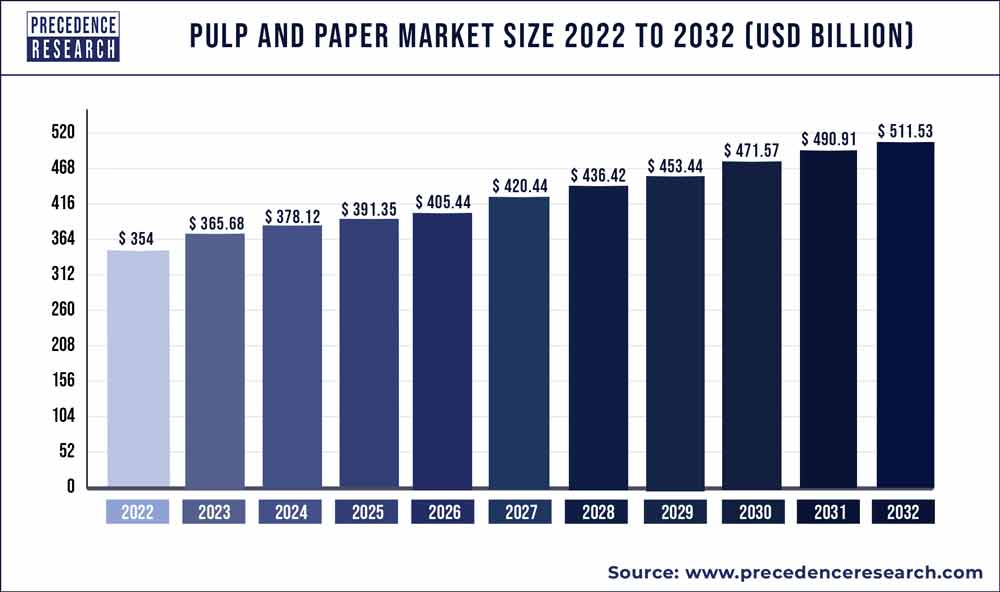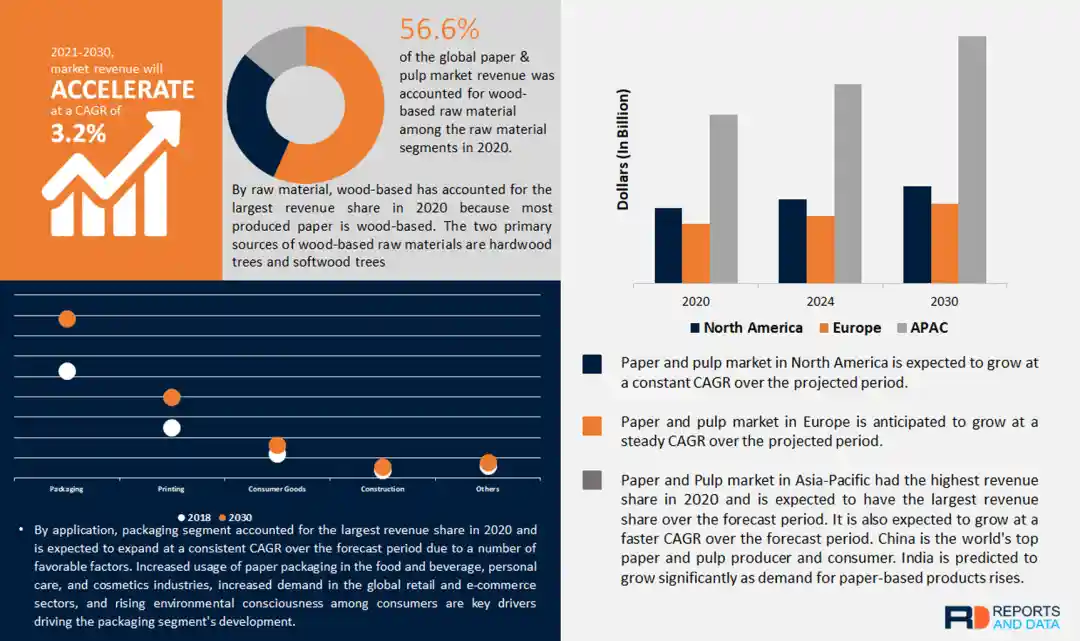كيف تتكيف صناعة اللب والورق مع اللوائح البيئية؟
تحليل صناعة اللب والورق: نظرة عامة على السوق
تُعد صناعة اللب والورق العالمية قطاعًا ديناميكيًا وأساسيًا يلعب دورًا أساسيًا في مختلف الصناعات والحياة البشرية اليومية. ستوفر هذه النظرة العامة على السوق رؤى قيمة حول حجم السوق الحالي واللاعبين الرئيسيين وتأثير التطورات التكنولوجية واللوائح البيئية على الصناعة.
حجم السوق الحالية لصناعة اللب والورق العالمية
شهد سوق اللب والورق العالمي نموًا مطردًا على مر السنين. في عام 2021، بلغت قيمة حجم السوق 351.53 مليار دولار أمريكي، ومن المتوقع أن يصل إلى 372.70 مليار دولار أمريكي بحلول عام 2029، بمعدل نمو سنوي مركب (CAGR) قدره 0.721 تيرابايت 3 تيرابايت. تهيمن منطقة آسيا والمحيط الهادئ على السوق، حيث استحوذت على 49.781 تيرابايت 3 تيرابايت من حصة السوق في عام 2021، حيث تعد الصين منتجًا ومستهلكًا رئيسيًا.
اللاعبون الرئيسيون في سوق اللب والورق
يساهم العديد من اللاعبين الرئيسيين في نمو وتطور صناعة اللب والورق. وتشمل هذه الشركات شركة International Paper، و Georgia-Pacific، و Nine Dragon Paper، و Stora Enso، وغيرها. تُعد شركة International Paper، التي تبلغ حصتها السوقية 6.35%، شركة رائدة عالميًا في إنتاج منتجات التغليف المموج ولب الورق والورق.
تأثير التطورات التكنولوجية واللوائح البيئية
أدت التطورات التكنولوجية واللوائح البيئية إلى تشكيل صناعة اللب والورق بشكل كبير. أدت التطورات التكنولوجية إلى تحسين الكفاءة التشغيلية والقدرة الإنتاجية وجودة المنتج. ومع ذلك، تأثرت الصناعة أيضًا بالحاجة إلى الامتثال للوائح البيئية المتطورة.
- التطورات التكنولوجية: شهدت صناعة اللب والورق تطورات في مجالات مختلفة، مثل الأتمتة والرقمنة وتحسين العمليات. وقد أدت هذه التقنيات إلى تحسين الكفاءة التشغيلية وتقليل النفايات وزيادة جودة المنتج. على سبيل المثال، ساعد اعتماد المنصات الرقمية والذكاء الاصطناعي (AI) على تبسيط إدارة سلسلة التوريد وتعزيز تخطيط الإنتاج.
- اللوائح البيئية: الـ صناعة اللب والورق واجهت ضغوطًا متزايدة لتبني ممارسات مستدامة والحد من تأثيرها البيئي. وتُعد إزالة الغابات واستهلاك المياه وانبعاثات الكربون من الشواغل الرئيسية لهذه الصناعة. ولمعالجة هذه القضايا، تركز الشركات على التوريد المسؤول للمواد الخام وعمليات الإنتاج النظيفة والشفافية في عملياتها. وتشجّع منظمات مثل الصندوق العالمي للحياة البرية (WWF) على توفير مصادر مستدامة للألياف وتراقب الشركات فيما يتعلق بإزالة الغابات والممارسات غير المستدامة.
الخاتمة
صناعة اللب والورق قطاع حيوي يخدم مختلف الصناعات والاحتياجات البشرية اليومية. وهي مستمرة في التطور والتكيف مع التطورات التكنولوجية واللوائح البيئية. إن حجم السوق الحالي لهذه الصناعة كبير، حيث يقود اللاعبون الرئيسيون نموها وابتكاراتها. ومن أجل ضمان الاستدامة على المدى الطويل، تتبنى هذه الصناعة التوريد المسؤول، وتعتمد مواد تغليف صديقة للبيئة، وتعمل بنشاط على الحد من تأثيرها البيئي. ومع استمرار نمو الطلب على الورق والمنتجات الورقية، فإن صناعة اللب والورق سيستمر في لعب دور حاسم في اقتصادنا العالمي.
الأثر البيئي وممارسات الاستدامة
لصناعة اللب والورق بصمة بيئية كبيرة، حيث تؤثر على الغابات وموارد المياه وجودة الهواء. ومع ذلك، تتبنى الشركات على نحو متزايد ممارسات مستدامة لتقليل هذه الآثار إلى أدنى حد ممكن وضمان التوريد والإنتاج المسؤول.
الآثار البيئية المرتبطة بصناعة اللب والورق
وتعتمد صناعة اللب والورق اعتمادًا كبيرًا على الأخشاب، حيث يُستخدم 33-401 تيرابايت من جميع الأخشاب الصناعية المتداولة عالميًا في عملياتها. وقد أدى هذا الطلب المرتفع إلى إزالة الغابات، وتحويل الغابات عالية الحفظ، والحصاد غير القانوني. وفي الفترة بين عامي 2004 و2017، فُقد أكثر من 160,000 ميل مربع من الغابات في المناطق الساخنة لإزالة الغابات.
ولهذه الممارسات غير المستدامة آثار ضارة على النظم الإيكولوجية والأنواع، مما يتسبب في تآكل التربة والتأثيرات المناخية وفقدان التنوع البيولوجي. وبالإضافة إلى ذلك، تستهلك هذه الصناعة كميات كبيرة من المياه وتطلق نفايات سائلة يمكن أن تلوث المسطحات المائية إذا لم تتم إدارتها بشكل صحيح.
الممارسات المستدامة في إنتاج اللب والتغليف والتعبئة والتغليف
لقد أدركت الشركات العاملة في صناعة اللب والورق الحاجة إلى ممارسات مستدامة وتعتمد تدابير مختلفة لتقليل تأثيرها على البيئة. ويتمثل أحد مجالات التركيز في إنتاج اللب المستدام. وينطوي ذلك على الحصول على الخشب من غابات تدار بطريقة مسؤولة، وتشجيع إعادة التشجير، واستخدام ألياف بديلة مثل المواد المعاد تدويرها.
يقوم منتجو اللب أيضًا بتطبيق تقنيات للحد من استهلاك المياه وتصريف النفايات السائلة. على سبيل المثال، يتم استخدام أنظمة الحلقة المغلقة وعمليات إعادة تدوير المياه لتقليل البصمة المائية للصناعة. علاوة على ذلك، يتم تنفيذ معدات وعمليات موفرة للطاقة للحد من انبعاثات غازات الاحتباس الحراري.
فيما يتعلق بالتغليف، هناك طلب متزايد على المواد الصديقة للبيئة. تستكشف الشركات بدائل لمواد التغليف التقليدية غير القابلة لإعادة التدوير، مثل البلاستيك. وتشمل خيارات التغليف الصديقة للبيئة المواد الورقية المشتقة من ألياف مستدامة المصدر. ويهدف هذا التحول نحو التغليف المسؤول إلى تقليل النفايات وتعزيز الاقتصاد الدائري.
مبادرات لتشجيع التوريد المسؤول والحد من إزالة الغابات
ولمواجهة تحديات إزالة الغابات والمصادر غير المسؤولة في صناعة اللب والورق، تعمل العديد من المبادرات والمنظمات على تعزيز الممارسات المسؤولة. إحدى هذه المنظمات هي الصندوق العالمي للحياة البرية (WWF)، الذي يركز على التوريد المستدام للألياف وإعادة التدوير من خلال برنامج الغابات إلى الأمام.
يراقب الصندوق العالمي للطبيعة الشركات فيما يتعلق بإزالة الغابات وانتهاكات حقوق الإنسان والممارسات غير المستدامة. ويهدف الصندوق العالمي للطبيعة، من خلال المشاركة مع أصحاب المصلحة في الصناعة وتطبيق معايير صارمة، إلى ضمان عمل صناعة اللب والورق بطريقة مسؤولة ومستدامة. هذه الجهود لا تفيد الغابات والنظم الإيكولوجية فحسب، بل تساهم أيضًا في سبل عيش المجتمعات المحلية والاقتصاد بشكل عام.
وفي الختام، فإن صناعة اللب والورق لها تأثيرات بيئية كبيرة، ولكن الشركات تتبنى بشكل متزايد ممارسات مستدامة لتقليل هذه التأثيرات. فمن خلال التركيز على إنتاج اللب المستدام ومواد التغليف الصديقة للبيئة والتعبئة والتغليف والتوريد المسؤول، تتجه الصناعة نحو مستقبل أكثر مسؤولية تجاه البيئة. وتؤدي مبادرات مثل برنامج "الغابات إلى الأمام" التابع للصندوق العالمي للطبيعة دورًا حاسمًا في تعزيز الشفافية والإنتاج النظيف والتوريد المسؤول. ومن خلال الجهود المستمرة والتعاون، يمكن لصناعة اللب والورق تحقيق التوازن بين النمو الاقتصادي والحفاظ على البيئة.
تجزئة الصناعة واتجاهات النمو
لب السوق
لب السوق هو أحد الدرجات الرئيسية في صناعة اللب والورق. ويُستخدم في الغالب لإنتاج مختلف منتجات الورق والألواح الورقية. وفي السنوات الأخيرة، شهد قطاع اللب السوقي نموًا مطردًا.
يتمثل أحد اتجاهات النمو الرئيسية في قطاع لب السوق في زيادة الطلب على مواد التغليف المستدامة. ومع ازدياد وعي المستهلكين بالأثر البيئي لقرارات الشراء التي يتخذونها، حدث تحول نحو حلول تغليف صديقة للبيئة. إن لب السوق، كونه مادة متجددة وقابلة للتحلل الحيوي، في وضع جيد لتلبية هذا الطلب المتزايد.
ومع ذلك، يواجه قطاع اللب في السوق أيضًا نصيبه العادل من التحديات. ويتمثل أحد التحديات الرئيسية في تقلب الأسعار. تتأثر أسعار اللب السوقي بعوامل مختلفة مثل ديناميكيات العرض والطلب، وتقلبات العملة، وتكاليف الإنتاج. تذبذب الأسعار يمكن أن يؤثر على ربحية منتجي اللب ويخلق حالة من عدم اليقين في السوق.
بالإضافة إلى ذلك، يمكن أن تشكل اللوائح المتغيرة والمعايير البيئية المتغيرة تحديات لقطاع اللب في السوق. نظرًا لأن الحكومات والهيئات التنظيمية تفرض لوائح أكثر صرامة بشأن الانبعاثات واستخدام المياه والمصادر المستدامة، يحتاج منتجو اللب إلى تكييف عملياتهم للامتثال لهذه المتطلبات.
قطاع المناديل والمناشف
يُعد قطاع المناديل والمناشف قطاعًا مهمًا آخر في صناعة اللب والورق. تُستخدم منتجات المناديل الورقية مثل ورق التواليت والمناديل والمناشف الورقية على نطاق واسع في المنازل والمؤسسات التجارية وقطاع الرعاية الصحية.
من حيث النمو والقدرة، كان أداء قطاع المناديل والمناشف جيدًا. فقد شهد هذا القطاع معدل نمو سنوي مركب (CAGR) قدره 4.25% منذ عام 2020. ويمكن أن يُعزى هذا النمو إلى عدة عوامل.
أولاً، أدى تزايد عدد السكان والتحضر وتغير أنماط الحياة إلى زيادة الطلب على المناديل والمناشف الورقية. علاوة على ذلك، أدت جائحة كوفيد-19 إلى زيادة الطلب على المناديل الورقية، لا سيما في قطاع الرعاية الصحية.
شهدت عدة مناطق نموًا كبيرًا في الطاقة الإنتاجية في قطاع المناديل والمناشف. فعلى سبيل المثال، شهدت الصين وتركيا والمكسيك استثمارات كبيرة في مرافق إنتاج المناديل الورقية. وتهدف هذه القدرة المتزايدة إلى تلبية الطلب المتزايد على منتجات المناديل الورقية في الأسواق المحلية والدولية على حد سواء.
أبلغت الشركات الكبرى العاملة في قطاع المناديل والمناشف عن زيادات كبيرة في المبيعات والكميات. فعلى سبيل المثال، شهدت شركتا كاسكيدز وكيمبرلي كلارك، وهما شركتان بارزتان في هذا القطاع، ارتفاعاً في مبيعات المناديل الورقية مدفوعة بزيادة طلب المستهلكين.
ومع ذلك، وعلى الرغم من اتجاهات النمو الإيجابية، يواجه قطاع المناديل والمناشف تحديات أيضاً. فالقطاع يتسم بالتنافسية الشديدة، حيث تتنافس العديد من الجهات الفاعلة على حصتها في السوق. وعلاوة على ذلك، يمكن أن يؤثر تقلب أسعار المواد الخام وتكاليف الطاقة ونفقات النقل على ربحية منتجي المناديل والمناشف.
ورق الطباعة والكتابة
يتأثر إنتاج ورق الطباعة والكتابة بعوامل مختلفة، بما في ذلك التركيبة السكانية الإقليمية والظروف الاقتصادية والتقدم التكنولوجي واللوائح البيئية.
في السنوات الأخيرة، واجه قطاع ورق الطباعة والكتابة بعض التحديات. فقد أدى تزايد رقمنة المحتوى وظهور الوسائط الإلكترونية إلى انخفاض الطلب على المواد المطبوعة. ونتيجة لذلك، شهد هذا القطاع معدل نمو سنوي مركب سلبي بلغ -1.681 تيرابايت 3 تيرابايت منذ عام 2020.
ومع ذلك، تجدر الإشارة إلى أن قطاع ورق الطباعة والكتابة قد شهد نموًا في بعض المناطق، لا سيما في آسيا. فقد شهدت بلدان مثل الصين والهند زيادة في الطلب على ورق الطباعة والكتابة. على سبيل المثال، أبلغت جمعية مصنعي الورق الهندية عن ارتفاع واردات ورق الطباعة والكتابة غير المطلي بمقدار 2141 تيرابايت في الربع الأول من العام.
يتأثر قطاع ورق الطباعة والكتابة أيضًا باللوائح البيئية وممارسات الاستدامة. نظرًا لأن الشركات تسعى جاهدة للحد من بصمتها البيئية، فهناك طلب متزايد على الورق المعاد تدويره والورق منتجات ورقية صديقة للبيئة. تستثمر الجهات الفاعلة في السوق في البحث والتطوير لتطوير بدائل مستدامة وتحسين الأداء البيئي لورق الطباعة والكتابة.
في الختام، يُظهر قطاع لب الورق في السوق، وقطاع المناديل والمناشف، وإنتاج ورق الطباعة والكتابة في مناطق مختلفة اتجاهات نمو متنوعة ويواجه تحديات فريدة من نوعها. ومن العوامل الرئيسية التي تؤثر على نمو هذه القطاعات وأدائها مبادرات التغليف المستدام وتغير تفضيلات المستهلكين واللوائح البيئية.
الأسئلة الشائعة حول تحليل صناعة اللب والورق
ما هي معادلة الدقة في سياق تحليل صناعة اللب والورق؟
في سياق تحليل صناعة اللب والورق، يتم حساب الدقة على النحو التالي: الدقة = الإيجابيات الحقيقية (tp) / (tp + الإيجابيات الخاطئة (fp)).
كيف يمكنني حساب الاستدعاء عند تحليل صناعة اللب والورق؟
عند تحليل صناعة اللب والورق، يتم تحديد الاستدعاء باستخدام المعادلة: الاستدعاء = الإيجابيات الحقيقية (tp) / (tp + السلبيات الخاطئة (fn)).
ما هو الدور الذي تلعبه التطورات التكنولوجية في صناعة اللب والورق؟
تعمل التطورات التكنولوجية في صناعة اللب والورق على تعزيز الكفاءة التشغيلية وجودة المنتج، مما يؤدي في النهاية إلى تحسين أداء الصناعة.
كيف تؤثر اللوائح البيئية على صناعة اللب والورق؟
تؤثر اللوائح البيئية على الصناعة من خلال دفع المبادرات الخاصة بالممارسات المستدامة والتوريد المسؤول والامتثال للمعايير البيئية المتطورة.
ما هي بعض التحديات التي يواجهها قطاع لب السوق؟
يواجه قطاع اللب في السوق تحديات مثل تقلب الأسعار والتغيرات التنظيمية والحاجة إلى تكييف العمليات للامتثال للمعايير البيئية.
في الختام، قمنا باستكشاف ديناميكيات صناعة اللب والورق العالمية.
اللاعبون الرئيسيون يقودون النمو وسط التحديات
تشكّل التكنولوجيا واللوائح التنظيمية هذه الصناعة.
تختلف اتجاهات سوق لب الورق والمناديل الورقية وورق الكتابة.
تحفز الآثار البيئية الممارسات المستدامة والمصادر المسؤولة.
ابق على اطلاع على اتجاهات الصناعة لاتخاذ قرارات مستنيرة.





